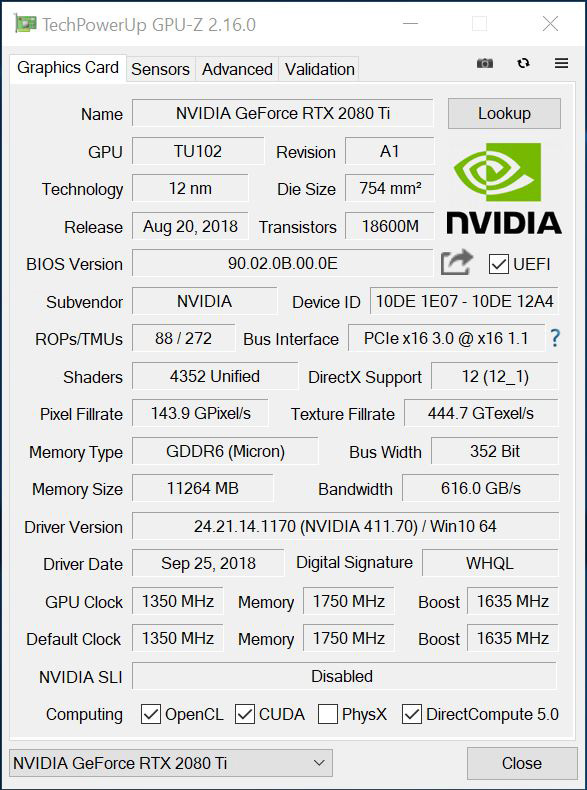NVIDIA GeForce RTX 2080 Ti Key Specifications
Here is a quick list of the card’s key specifications:
- CUDA Cores: 4352
- Peak FP32 Compute: 14.2 TFLOPS
- Tensor Cores: 544
- RTX-OPS Cores: 78T
- Giga Rays/s: 10
- Texture Units: 272
- Base Clock Rate: 1350 MHz
- GPU Boost Rate: 1635 MHz(OC)
- Memory Capacity: 11GB GDDR6
- Memory Bandwidth: 616 GB/s
- ROPs: 88
- L2 Cache: 5.5MB
- TDP: 260W
- SLI Support: Yes (x8 NVLink, x2)
- Max Resolution: 7680×4320
- Card Dimensions: 4.556″ x 10.5″
- Width: 2-Slot
- Max GPU Temperature: 89c
- Graphics Card Power: 260W
That 260W is a key figure as it is an increase over the GTX 1080 Ti generation. Now that the NVIDIA Titan RTX Launched with 24GB and NVLINK the RTX 2080 Ti is no longer the highest-end prosumer RTX card. On the other hand, the price of the RTX 2080 Ti aftermarket cards can reach around half that of the Titan RTX so one can trade the additional memory of the Titan RTX for two GeForce 2080 Ti’s worth of compute.
Although one gets more performance from the new cards, the price also increases significantly. The NVIDIA GeForce RTX 2080 Ti Founders Edition lists for around $1500, which is around twice what we were paying for the GTX 1080 Ti. NVIDIA is moving pricing up similar to how Intel has done the same on the server and workstation CPU sides.
Test Configuration
We will use the same setup that we have used in the past for our testing needs.
- Motherboard: ASUS WS C621E SAGE Motherboard
- CPU: 2x Intel Xeon Gold 6134 (8 core / 16 Threads)
- GPU: NVIDIA GeForce 2080 Ti 11GB Founders Edition
- Cooling: Noctua NH-U14S DX-3647 LGA3647
- RAM: 12x MICRON 16GB Low Profile
- SSD: Samsung PM961 1TB
- OS: Windows 10 Pro

GPU-Z shows the primary stats of our testing the NVIDIA GeForce RTX 2080 Ti. The TU102 Turing GPU clocks in at 1350 MHz, Boost speed goes up the 1635 MHz. And GDDR6 Memory at 1750 MHz. Pixel Fillrates run at 143.9 GPixels/s, and Texture Fillrate comes in at 444.7 GTexel/s.
The NVIDIA GeForce RTX 2080 Ti does not come with OC software, we will use ASUS GPUTweak that will set our card in three operating modes, Silent 1615 MHz, Gaming 1635 MHz, and OC Mode 1655 MHz to provide some sense of where this card falls relative to others that we have tested.
Now let us move onto our performance benchmarks.




Excellent Quick Simple and Rock Solid Review Mr. Harmon !!
Im sold ! all I need is 1 2080Ti card for my new system Build.
But 2 2080Ti’s SLI might work too Good :)
Thank You Sir !!
Eric Soovajian
Veteran
101st Airborne Air Assault Division